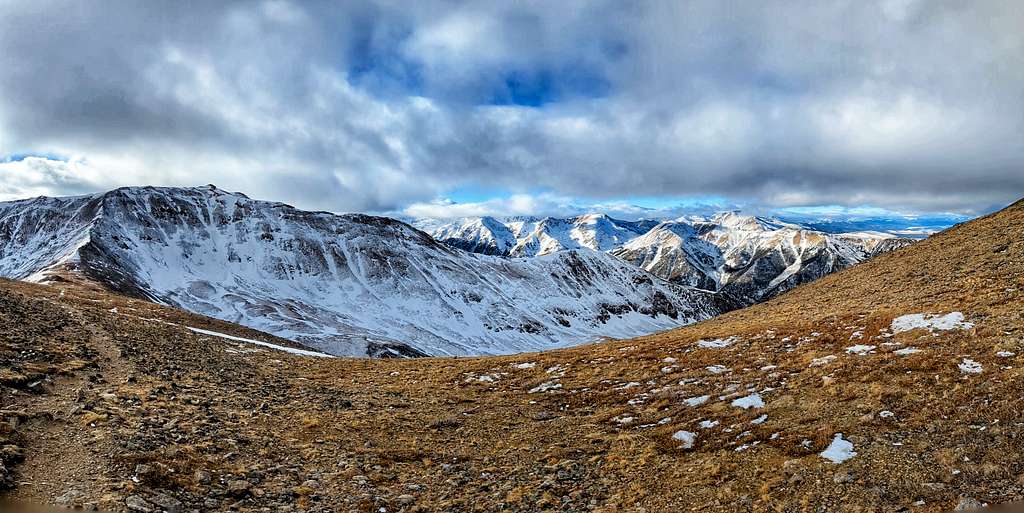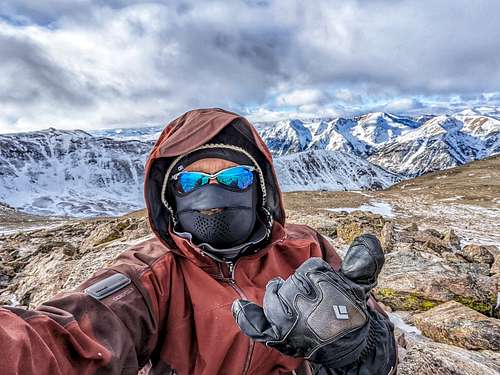|
|
Trip Report |
|---|---|
|
|
38.96470°N / 106.3383°W |
|
|
Dec 23, 2022 |
|
|
Hiking, Mountaineering |
|
|
Winter |
A cold and dry day

260 miles is a long way to drive only to get the vehicle stuck at the behest of two miles of snowy road. Sure, I could have driven further, but I’m not rolling the dice on a $400+ tow bill just for 30 more minutes of walking.
I stopped the car 1.3 miles past the normal winter road closure at Clear Creek Ranch (well, where the plows stop plowing anyway). I stepped out into the cold, pre-dawn morning, surveyed the road and began clearing out a large enough section of C&H sugar snow from the side suitable for a small car (I left the truck at home). Satisfied that the car wouldn’t get stuck, I turned it around, parked, bid Rammstein (The band) a fond adieu and left it there on the perimeter of #390.
I didn’t expect the bathroom at Missouri Gulch to be open but thought I’d check anyway…it was closed. Many years ago, as I was taking a J1 student (from South Africa) up the Decalibron in winter, I had checked the outhouse there at Kite Lake, it was actually open. As we were coming down Mt. Democrat, a blizzard rolled in like a souped up, 1976 Ford Torino. We took shelter in the outhouse, to the relief of Tyler. We rested and warmed up. He never experienced anything like that before. I was glad for him that we had shelter. Now, 15 years later, I still check outhouses to see if the Forest Service forgot to close them up for the season as an emergency source of shelter.
I walked across the parking area and stopped in the middle. I turned around admiring the gathering dawn and tracts of silent forest. Being able to comprehend what it means to be isolated in the wilderness will do one of two things: either invite fear into one’s heart or further broaden the smile on one’s face; confidence usually chooses.
I plodded across the footbridge over Clear Creek listening to the muffled deluge below me, an icy torrent held prisoner by its own means. I booted up the trail in shin-deep snow and donned my snowshoes near the nameless grave of a child taken by sickness (tuberculosis, I believe). I stared at the small barrow and quietly whispered a tender prayer before taking my leave. I’ve come across many graveyards and burials in the wilderness, but this little, almost forgotten mound has never failed to impress upon me.
I coursed my way up the serpentine switchbacks trudging through the snow like an arthritic camel. Of all the reasons why, I admire the winter so much, is the puritanical limitation it imposes upon nature. The forest becomes austere, fundamental and no longer able to hide behind its pageantry of green. The forest becomes stripped to its essence. I respect that.

The Sawatch Range is not among my favorite in Colorado. The usual cadre of suspects is to blame long approaches, lack of challenging terrain, accessibility (or the ease therefore of) are all to blame. Even the harshest desert or salt plain isn’t entirely without its gems. And I do believe Missouri Gulch is one such stone.
The morning ebbed calm and limitless; the kind of morning that only a sloth of a high-pressure system can deliver. I steeled through the upper forest quiet as a ninja. It was cold, maybe 8°-10°. But that’s why you shell out $265 on a good puffy.
I trenched through knee-deep powder setting off a couple radiating cracks and a whompf for good measure. The slope is low angle and I know from the summer, there is a generous amount of deadfall buried here. So, I wasn’t overly concerned. After 15 minutes, I reached tree line and the cabin.
I sat down on a snowy log and leaned against the cabin. There is a lot of quiet history here, a lot of memories enmeshed within the logs. I pulled my hat down over my eyes and silently admired those who came before.
Joseph Anderson and Elizabeth Winfrey met, lived and married in Missouri. They moved onto Joseph’s farm and led a good life. At some point during the 1830’s, they packed up their eight children and headed west to the Colorado Territory.
After serving in the American Mexican war of 1846-1848, Joseph cast his lot into the pursuit of mining. They built the cabin that many of us know all too well. The gulch was named after their former state, perhaps melancholy had a part to play in that.
Joseph was honorably discharged from the Army at the conclusion of the Civil War in 1864. He returned to his claim and family and died a few years later in 1869. This is when Elizabeth moved out of the mountains and led, a rather plain but happy life. She died in Pueblo in 1897.
I could almost feel the burden of history as I sat there. But now, like torn prayer flags, the memories are gone, flittered away on the currents.
I stood up, shouldered my pack and weaved through the Spartan trees to enter the world of the alpine. I was immediately greeted by the howling of coyotes. The first time ever, I’ve heard them up here. Since my plans also included Pecks Peak, an unranked 13er, I shuffled my feet east and started up the rocky slope weaving through the artifice of sickly green lichens. The stelae of rock pervading the slope whispered stories to me of the harsh cruelties of winter and the idyllic indifferences of summer.
I’ve been to Missouri Gulch more times than Elevation Brewing down in Poncha. I feel like this place is my home despite being only a pilgrim. I know every bend of its juvenile stream, past camping spots, hidden pitfalls of willows. Being solo, it’s easier to appreciate the synesthesia of whites, browns, greens and blue. So maybe, my emotions are providing an anachronistic and biased fabric of why I love Missouri Gulch so much. But of course, it’s hard to tell when you can’t see the forest for the trees.
The slope up Pecks Peak ascends 2,070’ from the Anderson cabin. I skirted by five bighorn sheep who didn’t seem to care I was there. So, I volunteered a few minutes and watched them. It was the first time I’d seen sheep up the valley. Honestly, there isn’t much to say about Pecks. In fact, with only 50’ of prominence, it hardly even qualifies as a bump.

Sometimes there’s objectives that intrigues us for no other reason other than it strikes a particular pose on our topo maps or the vantages ‘it’ may offer of surrounding peaks. Being able to hike the mild ridge from Pecks and see Belford from the north “scratched that itch” for me. It added to the day more than obtaining a new winter 14er.
I stayed as far hikers left as I could while I ascended Mt. Belford. I skipped the summit (since I was going to be crossing it later) and elected to follow the edge of some outcroppings. The snow was too hard on the eastern face to cross without points, so I wrapped back towards the top following a moat. Once I hit the flat nexus of the eastern ridge, I dropped down the rocky (and cold!) spine towards Oxford.
The lower ridge was snow-free and windblown as usual. The rock coming off Belford was covered in a patina of heavy frost with rime hiding in the darker recesses.
The wind started howling once I reached the saddle. This is also when I noticed my energy start to bonk. I hadn’t really eaten anything all day. I couldn’t take more than a few steps before I had to stop and rest. It felt like I was fighting quicksand. As much as I didn’t want to since there were no wind breaks, I dropped to my knees, back to the wind, flipped my hood up and forced myself to eat. Since I couldn’t leave my gloves off for more than a minute or so, eating the pack of tuna I had was a messy affair. The Laffy Taffy however, was dispatched quickly (God that stuff is delicious!). I gathered my strength and pulled myself from the ground, like separating two magnets and ambled on towards the summit.
On the summit, the wind chill was between -10° and -15° based on the temperature. I had a decent enough wind break to hide behind and wanted to stay longer. But the goal at this point, was to attain the valley floor before dark. And if my energy level thus far was any indication, I needed to get going.
The descent off Oxford and back to the saddle went by fast. I was half-way up Belford when I felt that familiar energy crash. I also started to slip and fall more frequently on the rocks. It took far longer to reach Belford’s summit than it should have.
Not wanting to stop and eat again, I popped a couple Jolly Ranchers and pressed on holding the side of my hood tight against my face. The clouds wisped across the summit with the force of a class-5 rapid, veiling me from everything. Regardless of the circumstances, it’s always a cool experience. Ok, not if there’s thunder involved.
At just past 5:00 pm, I hit the valley floor as darkness was devouring the last shreds of light. I followed the sastrugi of past trekkers like breadcrumbs through the willows and arrived back at the cabin where I took a hard-earned rest. Normally, I’d say I viewed everything for one last time. But obviously, that wasn’t happening. Instead, I drank in my share as I was coming off Belford. The clouds across the valley strafing Missouri Mountain looked like blue fog on a choppy ocean; a scene that would have made Renoir proud.
The snowshoe out was simply a labor of love following my track twelve hours prior. There were no other prints save for mine. So, I queued up another podcast, shed my shell, traded out my heavy gloves for simple fleece ones and marched out like a lone, solitary ant trying to find home.
I learned on this trip, that I need to force myself to eat more and that after twelve years of using the same mountaineering boots, it’s time to buy a new pair. Thankfully, I get Prodeals on outdoor gear.
Mt. Oxford and Mt. Belford are not the most technically challenging peaks out there [in winter]. But what they lack in problematics and Rubik’s, they excel in tenacity and arduous beauty.

